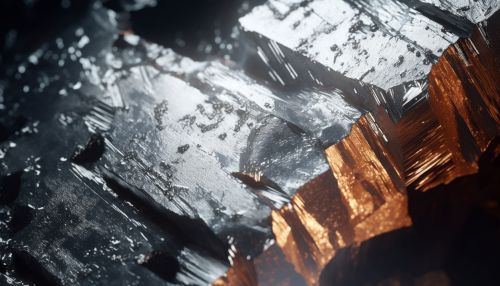Gallium
Introduction
Gallium is a chemical element with the symbol Ga and atomic number 31. Elemental gallium is a soft, silvery metal at standard temperature and pressure; however, in its liquid state, it becomes silvery white. If too much force is applied, the gallium may fracture conchoidally. It is in group 13 of the periodic table, and thus has similarities to the other metals of the group, aluminium, indium, and thallium. Gallium does not occur as a free element in nature, but as gallium(III) compounds in trace amounts in zinc ores and in bauxite.


History
Gallium was discovered by French chemist Paul Emile Lecoq de Boisbaudran in 1875 by its characteristic spectrum (two violet lines) in a sample of sphalerite. Later that year, Lecoq obtained the free metal by electrolysis of the hydroxide in potassium hydroxide solution. He named the element "gallia", from Latin Gallia meaning Gaul, after his native land of France. It was later claimed that, in one of those multilingual puns so beloved by men of science in the 19th century, he had also named gallium after himself: "Le coq" is French for "the rooster" and the Latin word for "rooster" is "gallus". In fact, he denied this in a letter to Nature in 1877.
Characteristics
Physical
Gallium is a soft, silvery metal, and elemental gallium is a brittle solid at low temperatures. If it is held in the human hand long enough, gallium will melt, since it melts at the temperature of about 29.76 °C (85.57 °F) (slightly above room temperature). The liquid metal has a strong tendency to supercool below its melting point/freezing point: droplets of gallium from a height of 1 m (3 ft) onto a hard surface readily form a soft, silvery-white globule that flattens upon impact, and the globule remains liquid for several minutes.
Gallium crystallizes in the orthorhombic system, and the lattice constants are a = 4.51 Å, b = 7.60 Å, and c = 4.99 Å. The exact nature of the layers depends on the temperature: below 27 °C (80.6 °F), the stable phase is α-gallium, which has a complex structure. Above this temperature, the stable phase is β-gallium, with a structure similar to that of α-gallium.
Chemical
Gallium is found primarily in the +3 oxidation state. The +1 oxidation state is also found in some compounds, although it is less common than it is for gallium's heavier congeners indium and thallium. For example, the very stable GaCl2 contains both gallium(I) and gallium(III) and can be formulated as GaIGaIIICl4.
Compounds of gallium in the +2 state are much less common. An example is gallium phosphide, GaP, where the gallium atoms are in the +2 oxidation state.
Occurrence and production
Gallium does not occur as a free element in nature, but as the gallium(III) compounds that occur in trace amounts in zinc ores and in bauxite. Gallium is mined only in trace amounts, mostly in bauxite and zinc ores. Over 95% of gallium consumption is in the electronics industry. The major source of gallium is through the extraction process of its primary mineral ores in the bauxite mines; this involves a method known as the Bayer process. Gallium is also found in coal, diaspore, germanite, and sphalerite.
Applications
Gallium is used in a variety of applications, from electronics to medicine. In electronics, it is used in the manufacture of semiconductors and diodes. Gallium arsenide, the primary chemical compound of gallium in electronics, is used in microwave circuits, high-speed switching circuits, and infrared circuits.
Gallium is also used in the production of artificial gadolinium gallium garnet for jewelry. It is also used in the preparation of pharmaceuticals and radiopharmaceuticals. Gallium is considered a technology-critical element.
Health and safety
Gallium is not considered a hazardous substance. Although it is not handled in large amounts, workers are nonetheless advised to wear protective clothing and use proper ventilation when handling it. Gallium compounds can be absorbed into the body through the skin and the lungs, and excessive exposure may result in some toxic effects such as nausea, diarrhea, vomiting, and severe skin rashes. The liquid metal can also wet skin and clothing, which may result in burns upon contact with the skin.
See Also
- Aluminium - Indium - Thallium - Bauxite - Zinc - Semiconductors - Diodes - Gallium arsenide - Gadolinium gallium garnet - Bayer process
